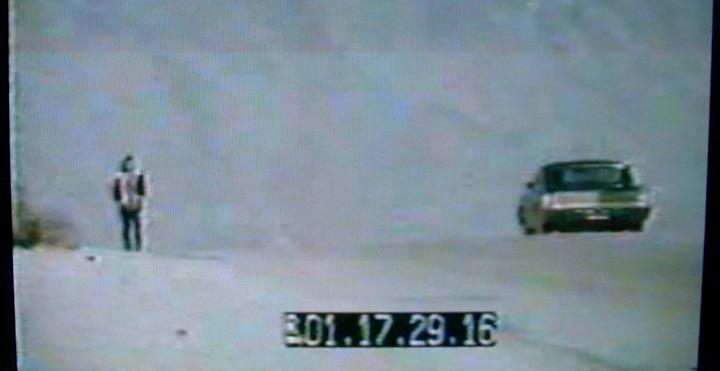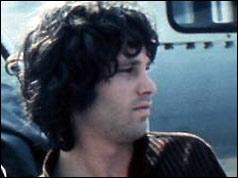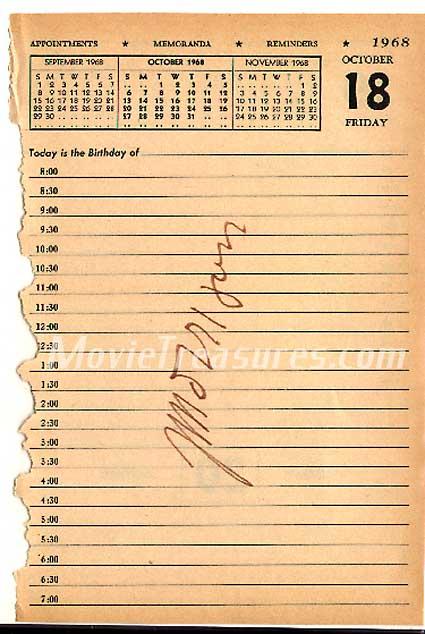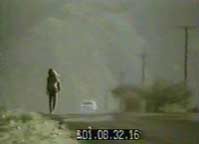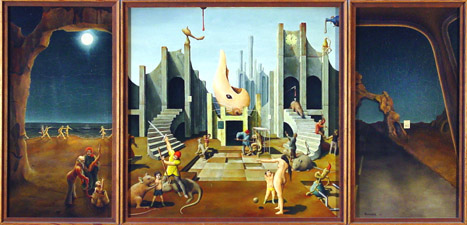 | HWY ("Hitchhiker") - film of Jim Morrison |
Jim Morrison''s film HWY - An American Pastoral 51:07 1969 г.игровой фильм с Джимом Моррисоном в главной роли |
A film written and directed by Jim Morrison. |
Killer on the Road° (=Убийца на дороге°) взят из сценария |
|
HWY - http://jimi1.bravehost.com/AHWYide.html |
|
Last project of Jim Morrison (The Morrison Triptych) (T. E. Breitenbach - http://www.tebreitenbach.com/posters/pmor.htm) |
|
The song "Riders on the Storm" was composed around the same time that Morrison was working on the proposed Hitchhiker film project and is a direct reference to his ideas for the film:
There''s a killer on the road
His brain is squirmin'' like a toad
Take a long holiday
Let your children play
If ya give this man a ride
Sweet family will die
Killer on the road, yeah
http://www.zodiackiller.com/mba/zm/541.html - Jim Morrison and serial killers
I first felt the need to write a review of Jim Morrison''s art film, "HWY," after I read two online ratings giving it a 1 and a 3 out of 10. It made me realize that people are not understanding this film. To understand it, one must keep in mind that Jim considered himself to be a poet above all, and that after Miami he was more than ever desirous to extend himself beyond music and more into poetry, and breaking through further to new frontiers in film. His vision and desire for film was to break on through and exceed even his best and highest visionary work as exemplified in his highest artistic achievements in epics such as "The End" and "When the Music''s Over."
In this artistic context we are given "HWY" without a knowledge of how much he felt he achieved of his vision in this unfinished work. Unless there are written records or friends with memories of his comments, we do not know how much he felt he accomplished in this piece. There is obviously genius in evidence here, but was it just an initial exploratory dabbling, or did he achieve 20% of what he envisioned, or 80%? While there is some legitimacy in the concept that he just wanted to take the camera and see where it took him, just as he liked to do in the improvisational sections of the concerts, there is nevertheless a direction and a carefully crafted element to the film as well.
Interpretation of the film is not possible without some familiarity with the use of symbolism in art. In making "Wilderness, The Lost Writings of Jim Morrision," Lisciandro makes reference to the fact that he wanted to choose the poems that were accessible to the average music fan who was curious about the poetry. But this is obviously not adequate, because if we eliminate the deeper material, we only become familiar with Jim''s work at its lightest and easiest and miss out on his deepest and most profound work. Thus with Morrison poetry being taught in college, there is need for a definitive and comprehensive book of all his poetry. Likewise, with "HWY" being somewhat difficult and inaccessible, it nevertheless needs to be addressed to fully understand the depth of Jim Morrison as an artist.
In comparative literature we are taught that nothing exists by itself, but only in comparison to something else. So the first clue as the movie opens is that Jim is in the desert, but we are shown a waterfall. So, desert represents death, water represents life, and the waterfall, the fountains of life. When we first see Jim, he is immersed in water, a symbol of the womb, and his emergence from the water represents birth. Tribal music here, contrasted to civilized music later, suggests the birth of a shaman.
We then see images of Jim basking in the joy of life, and then he undertakes a journey. One of the common complaints about the film are these long passages of shots of Jim''s journey. There has been some comment that this is just Jim''s working in the milieu of his time where these long passages were typical of art house cinema of the time. But it is more than that. The version of "2001 - A Space Odyssey" that was commonly shown was a shortened version. The first version released contained long, boring shots of the space ship traveling through space. Kubrick''s intent was to illustrate the immensity of space and how long it takes to engage in space travel. This is based on Homer''s "The Odyssey" where the same effect was used to illustrate the immensity of the ocean and how long it takes to engage in sea travel. But the audiences didn''t get it, and so they had to withdraw the initial print and shorten it.
In "HWY," the lengthiness of the journey is also deliberate, but it serves multiple and different functions. The first clue is to get you to understand that this story is about a journey, so Jim had to make the journey passages long enough to make sure you got the point. Any shorter, and it would have looked like just another scene. More specifically, in artistic terms, it is about the hero''s journey. Since the days of the story of Prometheus breaking on through to the other side to steal fire from the gods and bring it back to earth to benefit mankind, the genre of the hero''s journey has always been about crossing the threshold to the divine and bringing back something for mankind. This is what Jim does when he breaks on through and brings his music and poetry back for our benefit. For an introduction to this concept, Joseph Campbell has published some excellent work on this matter. For a brief treatment, see:
The Hero with a Thousand Faces
For a more thorough treatment, see:
Transformations of Myth Through Time
So, while I already gave away the ending (did you catch it?), as they say, the journey is often more important than the destination, so let''s see what else is here. The film is called "HWY," but is subtitled "An American Pastoral." This is another exercise in contrasts, the bleakness of a highway and the beauty of nature. Perhaps that is why Jim insisted the movie is called "HWY," not "HIGHWAY," because something is missing besides the letters. The sirens sounding over the highway shots on the opening credits suggest an invalid authority is a contributor to the bleakness of man-made society. So the next function of the journey passages is to give a sense of the beauty and serenity of nature. It is important that this section was long in order to build the sense of serenity and beauty to form a strong enough contrast to the bleakness of the highway and city sections.
So we are done with that; let''s move on to the highway section. It starts out with Jim''s hitchhiking, but no one picks him up, a sort of bleak commentary on man''s inhumanity to man. As an aside, the scene of Jim getting out of the car in the sand adds another element of commentary. It seems he just found the car that way, since it is already buried and looks like someone had to do some digging to get a door open (oops! trying to open a door and break on through?! - it''s hard work!), and his rage on breaking the windshield seems to indicate that he didn''t find anything in it. Maybe a commentary on those who try to find fulfillment in cars? It''s empty, there''s nothing there.
www.doors.com
За свою короткую жизнь Моррисон успел снять экспериментальную картину «HwY» и закончить документальный фильм о Doors «Пир друзей» вместе с двумя своими друзьями – Полом Феррарой и Фрэнком Личиандро. Во время второго года, проведенного в UCLA, в 1965-м, Джим посещал курс кинопроизводства у Терри Маккартни-Филгейта, канадского кинодокументалиста и преподавателя. В эксклюзивном интервью «Американским легендам» Терри Маккартни-Филгейт, живущий ныне в Торонто, вспоминает Джима Моррисона.
- Что из себя представляла UCLA тогда, в начале шестидесятых?
- Это было потрясающее место. Директором школы был Колин Янг, позже основавший Национальную Киноакадемию в Британии. Вокруг него собирались чудаковатые люди и эксцентрики всех мастей. Любой, кто его интересовал, мог записаться на курс. В моем классе учились бывший полицейский, один араб, израильтянин…
- И двое парней, которых звали Рэй Манзарек и Джеймс Моррисон.
- Точно. Вообще, всех, кто обладал крутым нравом, Колин отдавал на мое попечение. Так как я не был профессиональным кинематографистом - обычным представителем преподавательского состава, мне доставались все буяны и одиозные личности. Моррисона направили ко мне в класс, потому что до этого он попал в неприятности. По-моему, он угрожал избить кого-то.
- Вы наблюдали когда-либо эту темную грань его натуры?
- Помню, однажды я побывал на его квартире, за пределами студгородка. По меркам UCLA он был довольно богат. Его отец был адмиралом. Деньги у него водились. Так вот, Джим снимал там один из эпизодов своей короткометражки. Я согласился немного помочь с кинопроектором. Тут я заметил висевшую на стене мишень для игры в дартс на фоне вырезок из разворотов «Плейбоя». Помню, я подумал: женщины не слишком его интересуют. Когда я ему об этом сказал, он засмеялся. Он был не слишком общителен. Был одиночкой.
- Расскажите о фильме, который Джим снимал.
- Это был коллаж – в фильме не было сюжета, он был построен из различных образов и изображений. Помню одну из сцен. Подруга Джима, облаченная в пояс с подвязками, танцевала, стоя на телевизоре. В это время на экране появляется изображение буддистского монаха, совершающего акт самосожжения. Джим не мог знать об этом заранее. Это было, с точки зрения съемок, чистым везением. Картина Джима, вообще говоря, была не самой шокирующей – один из студентов проводил съемки в городском крематории. Но нигилизм тогда был популярен, а начинающие кинематографисты всегда подражают другим. Я полагаю, Моррисон видел фильм «Triumph of the Will».
- Также одним из ваших учеников был Рэй Манзарек.
- Для студентов Рэй был кем-то вроде гуру. Он всегда мог дать совет любому из однокурсников. Джим обладал талантом, но Рэй ко всему прочему был очень организован. Джим был несобран, недисциплинирован. Свой фильм он так и не довел до конца. Не захотел заниматься монтажом. Это было в шестидесятые. Было слишком трудоемко. Я поставил ему «не закончено».
- Как бы вы охарактеризовали личность Джима?
- Он был нарциссистом. То, как он стоял поблизости, вытягивал шею, отгибался назад… У него уже был этот образ самого себя…
- Проявлял ли Джим в то время интерес к пению?
- Вообще, насколько я помню, Рэй Манзарек тогда организовал свою группу под названием «Rick and the Ravens». Однажды я услышал их на сборище студентов в Санта-Монике. Джим был их вокалистом, но в те времена ничем особенным не выделялся. Никто и не предполагал, что его ждет успех.
- Во время съемок фильма «The Doors» Оливер Стоун связывался с вами?
- О фильме я понятия не имел до его выхода. Я даже не видел смысла в том, чтобы его смотреть. Я лично знал Джима Моррисона и успел составить свое собственное впечатление о нем.
- А что стало с тем студентом, который снимал фильм в здании крематория?
- Не знаю. Наверное, вышел на пенсию и держит мотель где-нибудь на Среднем Западе…
Перевод Михаила Гунина
http://www.101.km.ru
http://www.americanlegends.com/Interviews/morrison_film.html
c http://www.beatles.ru/books/paper.asp?id=1343&cfrom=3&city=&issue=&author=
http://www.doorsmania.ru/shopcopy.htm
http://www.subcin.com/jimhwy.htm
http://www.kinopoisk.ru/level/1/id_film/225363/
http://www.kinopoisk.ru/level/4/id_actor/270868/#writer
http://us.imdb.com/name/nm0607186/
HWY is a story about a man (MORRISON) coming down from the mountains, out of the wilderness and into the harsh realties of civilization. Along the way hitch-hiking through the desert, somehow obtaining a car more than likely through violent actions. Coming to the city and being confronted with buildings, cars, graffity, mass population.
There are some great shots of Jim crossing a river, all wild with his beard flowing. To scenes with him just aimless wandering down a deserted desert road in the middle of nowhere. Where we then see MORRISON tearing down the highway in a car at top speed, screaming with the look of the devil in his eyes.
It''s implied that Jim hits a dog and you see this injured dog, bleeding on the side of the road, moaning in agony with blood pouring out of it''s wounds.
The car is written off and Jim is seen jumping up and down on the roof with delight.
Morrison arrives in the city and the concrete jungle and we are confronted by images of modern man and the way he has consumed the earth with his needs..
Overall this movie really is terrible and something I found very hard to sit through after the inital images of MORRISON. It''s great to see him exploring the mountain side but after that the film goes down hill big time.
To Jim''s defence it was never finished but even if it been it''s hard to see that it would have made much of a difference.
Out of 10 I''d give it 3 and that''s only for the new images of Jim Morrison.
After HWY, the ''Soft Parade'' video was shown featuring the entire performance
Toward the end of the video Kelsey and I decided to get out of there. It was nearly 11 and we had seen and heard enough and now wanted to get out into the night to have some drinks for Jim and to party the night away - http://www.expage.com/jimhwy
http://forums.gameguru.ru/board-music/action-display/num-1113468068/
http://softparade.narod.ru/noone/9.htm
http://www.crystal-ship.com/albums.php?act=viewalb&albumId=30 -the lost interview
Buick Riviera / Movies / Hollywood
Plans
HWY history
HWY -WHY?
UCLA, 1965, Джим посещал курс кинопроизводства
